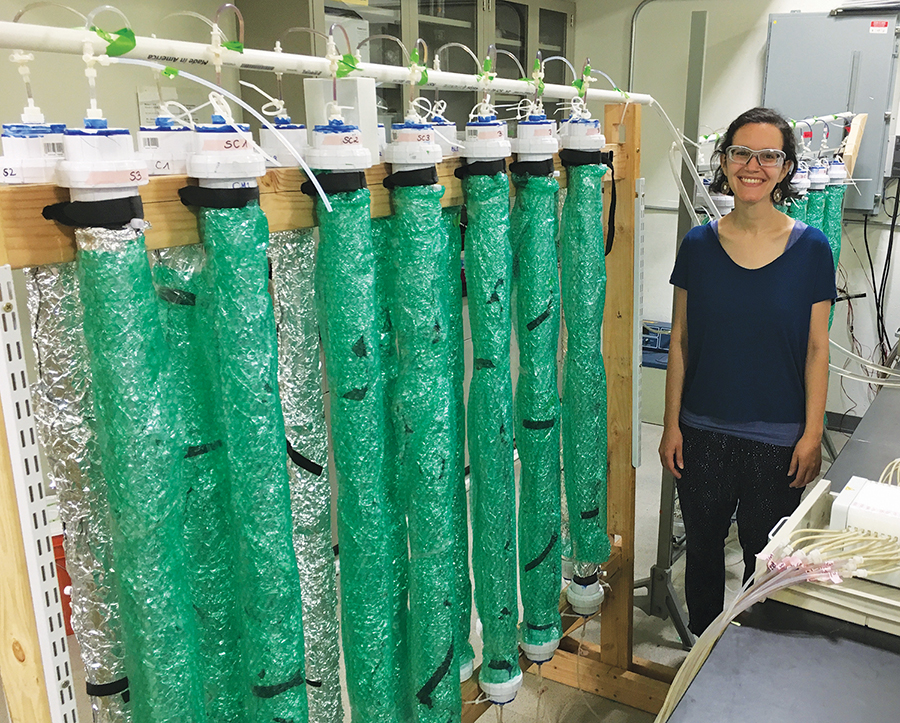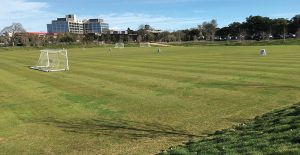
Postdoctoral researcher Stephanie Spahr uses test columns at Stanford University to evaluate how biochar and other amendments perform as filters for removing contaminants from urban runoff. Photo by Richard Luthy.
Last winter was so wet for so long that we could hardly get rid of all that water fast enough, as jaw-dropping volumes of stormwater rushed along gutters, into stormdrains, and ultimately out to sea. Even so, people were hard-hit in flood-prone regions, particularly central Sonoma County. In late February, the Russian River ran high enough to turn the towns of Guerneville and Monte Vista into islands. Now that we’re deep into the dry season, though, it would be great to have some of that water back. The need to use stormwater as a resource will likely intensify with climate change, which is projected to trigger droughts that hit more often and last longer.
A major barrier to using urban stormwater is that it’s dirty. Rain starts picking up contaminants the moment it hits rooftops, streets, and other hard surfaces, as well as landscapes laden with fertilizer and herbicides. Pollutants include nutrients, heavy metals such as copper and lead, and a host of pesticides, flame retardants, and other toxicants collectively known as trace organic compounds. Stormwater typically gushes directly down drains with little treatment, apart from grates that help block trash and debris.
New research shows that a cost-effective, low-tech approach can go a long way toward cleaning up urban stormwater. Researchers collected runoff from Fryer Creek, which drains the City of Sonoma, and treated it with a combination of woodchips and biochar. “The system worked really well,” said Richard Luthy, a Stanford environmental engineer who led the study, which was recently published in the journal Water Research, in partnership with the Sonoma County Water Agency. “It removed all the nitrates and trace organics,” Luthy said. With the exception of zinc, the system also did a good job removing heavy metals from stormwater.
Woodchips clean up nutrient pollution by serving as a carbon source for bacteria that consume nitrate. Similarly, woodchips remove heavy metals, presumably by promoting the growth of another type of bacteria. Specifically, these microbes turn heavy metals that are dissolved in water into solids, which then precipitate out of the water. In turn, biochar removes pesticides, flame retardants, and other trace organic compounds. Like the activated carbon common in home water filters, biochar collects these compounds on its surface.
Biochar has the advantage of being far cheaper than activated carbon, at about one-tenth the cost. Moreover, biochar can be environmentally friendly. Luthy used biochar made of bark and other waste from lumber mills. “The plant waste would otherwise decompose and return carbon dioxide to the atmosphere,” he explained. “Biochar is a green material that doesn’t decompose — it sequesters carbon.”
The Sonoma biochar treatment project arose from a federal research center that Luthy directs. The center, called Re-inventing the Nation’s Urban Water Infrastructure (ReNUWIt), fosters collaboration between university researchers and water agencies. “We’re interested in more sustainable solutions to our urban water supply,” he said.
Stormwater in cities could be captured, treated, and used to replenish aquifers in areas with sandy soil. “You can’t be on top of rock and you can’t have a lot of clay soil,” Luthy said. “The edge of the San Francisco Bay is primarily clay, so you need to go further out for soil that can infiltrate.” Suitable soil is found in parts of Alameda, Santa Clara, and Sonoma counties.
Now Luthy wants to test his biochar treatment in an urban setting. In Sonoma County, he estimates that it would take about half a percent of a city’s land to capture and clean stormwater. He envisions a distributed stormwater treatment system that repurposes existing green spaces like athletic fields, power line easements, and sidewalk strips.

This soccer field at Stanford University serves as a stormwater catch basin for high flows during winter storms. Photo by Richard Luthy.
The push to transform stormwater from a flood threat to a resource comes partly from recent state requirements. Projects funded by Proposition 1 — the $7.545 billion water bond that California voters passed in 2014 — must provide multiple benefits. In addition, the 2014 Sustainable Groundwater Management Act mandates that depleted aquifers reach sustainability by 2042, and two decades is not enough time for them to recharge naturally. “We’re looking for projects that can capture stormwater to reduce flooding and recharge groundwater,” said Kent Gylfe, a Sonoma County Water Agency (SCWA) engineer.
That said, finding a place to test Luthy’s biochar treatment in a stormwater capture system is easier said than done. “The public loves it in concept,” said Susan Haydon, an SCWA planner and lead on Sonoma County’s stormwater resource plans, which agencies must submit to the state to be eligible for Proposition 1 funding. “But there’s pushback when you get down to the property level.”
Another ReNUWIt researcher is helping Haydon and Gylfe zero in on sites that the public won’t oppose. “Neighbors generally object to the appearance of systems, potential nuisances like breeding mosquitoes and collecting trash, and fears that children will wander into stormwater capture basins and hurt themselves,” said William Eisenstein, executive director of the UC Berkeley Center for Resource Efficient Communities. “We’re identifying hotspots for these non-technical issues.”
His team recently developed a way to find sites that are acceptable from both technical and non-technical standpoints. The method takes a map of technical feasibility — based on soil suitability and groundwater recharge potential — and overlays it with a map of community land-use values based on stakeholder interviews. A pilot test in the Petaluma area revealed that the best sites were concentrated at mid-elevations, along the transition between urban and rural lands. “This makes sense,” Eisenstein said. “It’s not in the dense urban core at low elevations, or in the grazing lands at upper elevations.”
This finding fits with Haydon’s and Gylfe’s experiences. Many rural residents are farmers who consider themselves to be environmental stewards. In contrast, retrofitting urban sites can be challenging because “people already have preconceived ideas of what the land use should be,” Gylfe said. The story could be different, however, in communities that are not yet established.
Next Eisenstein, Haydon, and Gylfe plan to proactively identify hotspots of public acceptance for stormwater capture and treatment sites. Their goal is to incorporate these systems into a new development in Sonoma County. “By doing this in the context of a development proposal, we can put systems in to minimize objections,” Eisenstein said.

